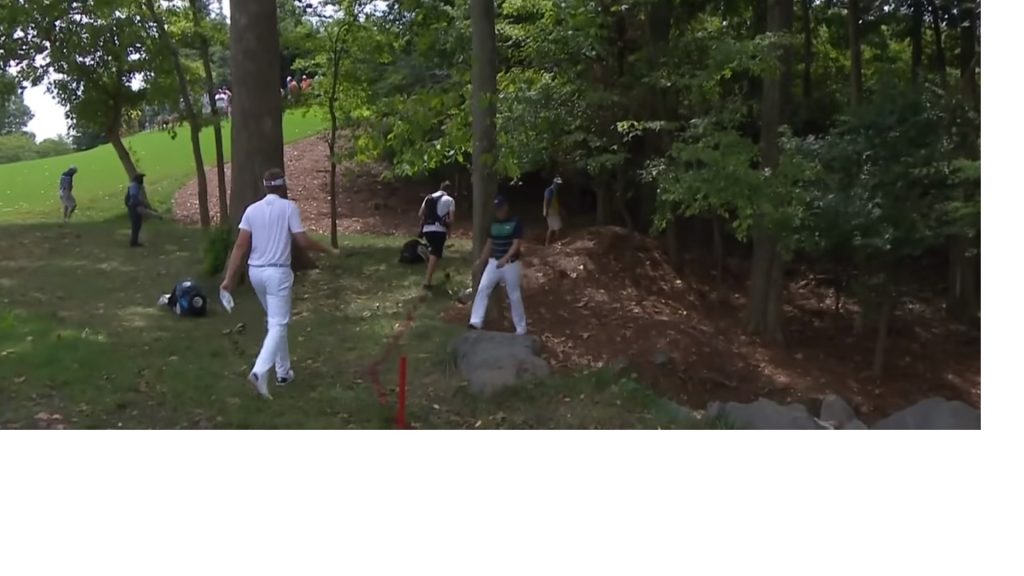This weekend we had the privilege to witness a great ending to a great championship and a first-time winner crowned in Justin Thomas as the 2017 PGA Champion. If you tuned into the broadcast early enough on Sunday, you would have caught a glimpse of a featured group with Jordan Spieth and the seemingly constant Ryder Cupper Ian Poulter.
On the 8th hole, Poulter hits his tee shot well right and into an area of trees that was marked as a lateral water hazard. When Poulter and Spieth arrived at this area, the group used the allotted five-minute time to search for a lost ball. When it was not found, Poulter assumed he would be able to utilize Rule 26 (Water Hazards) and be able to drop a ball within two club lengths at the point at which the ball last crossed the margin of the lateral water hazard.
However, their walking Rules official correctly pointed out to Poulter that without knowledge or virtual certainty that the ball was in the lateral water hazard, he may not proceed under the water hazard Rule and would have to proceed under the stroke and distance option for a lost ball. At this point, Poulter begins to argue with the Rules official by exclaiming that there could be no way the ball could lie anywhere else, other than in that lateral water hazard.
So, what is “knowledge or virtual certainty” according to the Rules? Decision 26-1/1 gives us exactly the answer. It states, in part,
“When a ball has been struck towards a water hazard and cannot be found, a player may not assume that his ball is in the water hazard simply because there is a possibility that the ball may be in the water hazard. In order to proceed under Rule 26-1, it must be “known or virtually certain” that the ball is in the water hazard”¦..
However, “virtual certainty” also means that, although the ball has not been found, when all readily available information is considered, the conclusion that there is nowhere that the ball could be except in the water hazard would be justified.
In determining whether “virtual certainty” exists, some of the relevant factors in the area of the water hazard to be considered include topography, turf conditions, grass heights, visibility, weather conditions and the proximity of trees, bushes and abnormal ground conditions”¦.”
Using this definition, the area in question had far too many areas that were just adjacent to the lateral water hazard where the ball could have hidden that were outside of the lateral water hazard (through the green). But after a few minutes, the Rules official did eventually relent from his initial stance and agreed that yes, the ball is virtually certain to be inside the lateral water hazard. Ian Poulter’s five minutes to search for his ball had timed out and he now either had to proceed under the stroke and distance option for a lost ball or the water hazard rule. Obviously, his preference was the water hazard rule as this would save him from going some 280 yards backwards to the teeing ground.
Again, the Rules official had decided that based on the evidence presented by all sides that the ball was virtually certain to be in the lateral water hazard.
However, even after all that discussion and contention from Poulter, the ball was then actually found just outside the lateral water hazard (lying through the green). It was found buried in the pine needles from the impact of the tee shot.
Now there is a whole new situation here in that the ball was deemed (by the Rules official) to be virtually certain it was in the lateral water hazard, and subsequently was found outside the lateral water hazard. As you may know by now, the Rules contemplate this type of situation as well.
Decision 26-1/3.5 is the best decision for this instance. While the decision is not exactly what happened in this situation, it is as close a decision as it gets. It states that on the off chance the ball is found to be outside of a water hazard (lying through the green) after it was known or virtually certain to be in a water hazard, a player that has dropped a ball in accordance with the Rules must now continue play with that dropped ball, as he had proceeded correctly.
In this instance, Poulter’s five minute search time had expired (the original ball is now lost) but he had not yet dropped another ball in accordance with the water hazard Rule. But again, the Rules official had deemed with knowledge or virtual certainty that the ball was in fact in the lateral water hazard. At this point, it is irrelevant that the ball was found outside the lateral water hazard.
Poulter then of course took his two club lengths from the point at which the ball last crossed the margin of the lateral water hazard and played out the hole.


